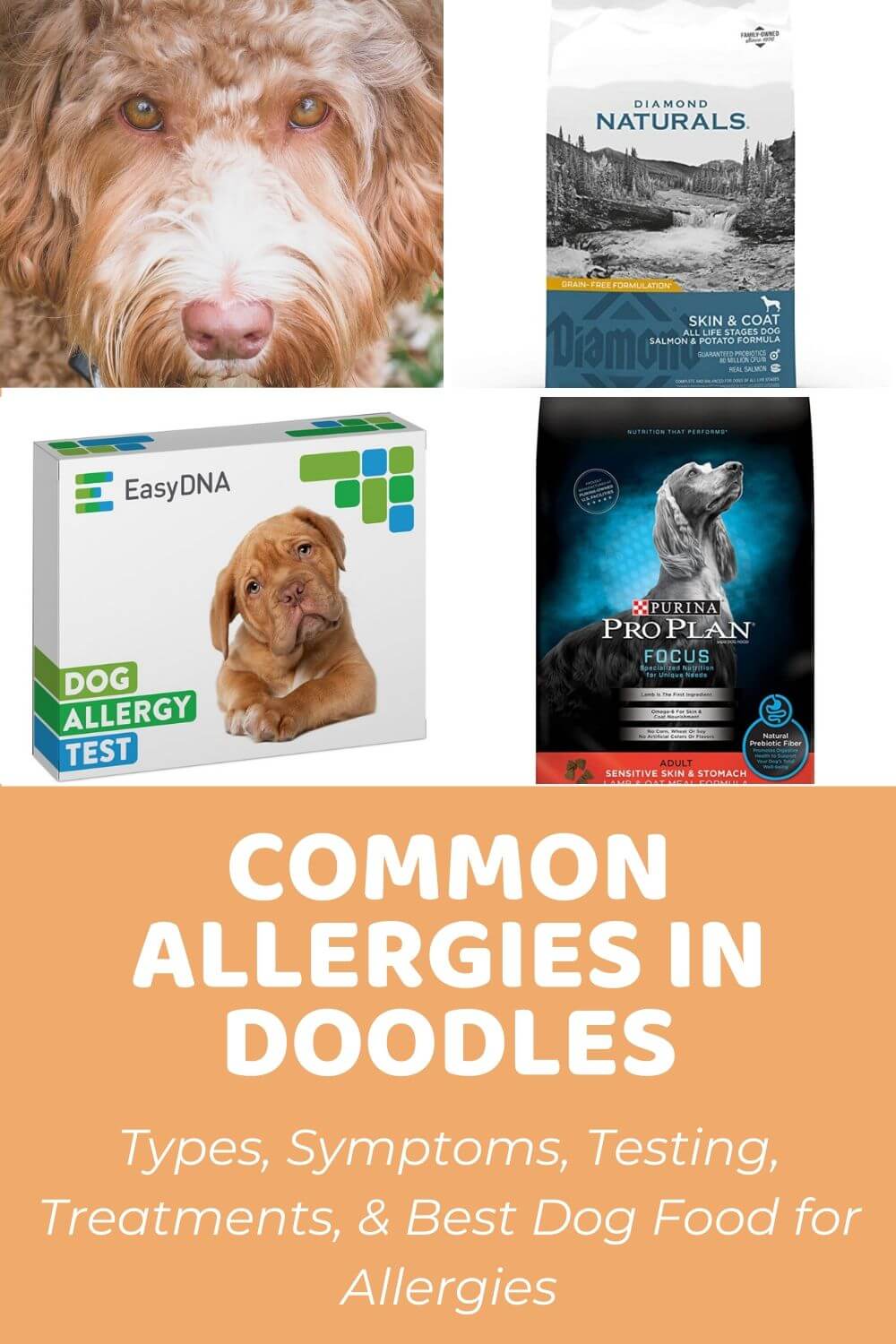In this article, we’ll discuss the most common Labradoodle health issues that you should be aware of. We’ll also be sharing with you the symptoms to look out for and discuss the best prevention and treatment options for each Labradoodle health issue. Let’s dive in!
Labradoodle Health Issues: Introduction
If you know a little bit about Labradoodles, you know that this Doodle breed is pretty much the perfect dog anyone could ever wish for. Playful, affectionate, and intelligent, combined with the low-shedding coat from the Poodle parent – literally, the dream! Not to mention, as they’re a mix of two different breeds, they’re oftentimes super healthy with a long life expectancy. It’s no surprise that Labradoodles have become so extremely popular all across the globe. Even though it may seem like the Labradoodle has it all, there are still certain Labradoodle health issues that this hybrid breed can develop.
Whether you’re planning to adopt a Labradoodle puppy or you’ve already welcomed this adorable fluffball to your family, it’s important that any Doodle owner knows exactly what to expect. After all, you’ll want to be fully prepared if any Labradoodle health problems start to appear.
For this very reason, we’ve decided to prepare a comprehensive guide on all the major Labradoodle health issues that your pup may be prone to. We truly believe that knowledge is power. And in the case of Labradoodle health issues, you’ll have the best chance of keeping your pup healthy and happy if you’re fully informed and take action as soon as possible.
Do Labradoodles Have Health Issues?
Although Labradoodles are usually considered healthier than their purebred Poodle and Labrador Retriever parents, there’s no way to ensure that a dog will never experience any health problems. When it comes to Labradoodles, health issues can be inherited from either of the parent pups. For instance, some health issues are more common in Poodles, others are more common in Labrador Retrievers, and some health problems overlap in both breeds.
Nevertheless, Labradoodles do benefit from hybrid vigor, which gives them a great advantage in terms of health. Hybrid vigor means that a cross-breed has a smaller chance of inheriting the health problems most common in the parental breeds. To put it simply, cross-breeds often inherit the best qualities from both parents. However, hybrid vigor is most prevalent in first-generation Doodles and it may start to diminish with each consecutive generation.
An Overview Of Labradoodle Health Issues
So, now that we’ve covered the background, let’s jump into the most common Labradoodle health issues that any Labradoodle owner should be aware of…
Labradoodle Joint Problems
One of the most common Labradoodle health issues are joint problems that can manifest in various forms. These are typically hip and elbow dysplasia, knee problems like patellar luxation, and cruciate ligament damage. Not only do they cause pain and discomfort for your dog, they can seriously alter your dog’s quality of life.
All sizes of Labradoodles are at a risk of developing joint problems, but patellar luxation is one of the most common Toy and Mini Labradoodle health issues.
To prevent joint problems, you should look for dog food formulas that contain ingredients like glucosamine or chondroitin. If your pup is struggling with excess weight, it’s crucial you feed them only the recommended amount of food, preferably a dog food formula designed for weight management.
Additionally, for Toy and Miniature Labradoodles, you might want to look into dog foods that are specially formulated for small breeds. Similarly, for large Labradoodles, it might be reasonable to switch to a formula that’s specially designed for large breeds. Both options take into account the specific needs of smaller and larger breeds, and help avoid improper development and skeletal disorders.
Labradoodle Hip Dysplasia & Elbow Dysplasia
Hip and elbow dysplasia are common Labradoodle health issues in larger Doods. It’s a hereditary disease that weakens the hip and elbow joints. Additionally, it can result in arthritis.
Hip dysplasia is caused by various factors, such as genetic disorders, obesity, or unethical breeding. Luckily, ethical breeders always conduct extensive health testing on their parent dogs to minimize the risk of puppies developing hip dysplasia.
The most common symptoms of hip and elbow dysplasia include:
- Pain, stiffness, or limping
- Decreased activity and range of motion
- Difficulty standing up, climbing stairs, jumping, or running
- Lameness
- Bunny hopping
- Loss of muscle mass
Labradoodle Cruciate Ligament Damage
Cruciate ligament damage a.k.a. CCL is a very painful condition, where one or both cruciate ligaments tear or completely rupture. Cruciate ligaments hold the knee together and they typically become damaged over time due to excess bodyweight, injury, or inherited weakness of the ligaments.
In severe cases of CCL, surgical intervention might be the only treatment option. Additionally, Doods who’ve struggled with CCL often develop arthritis later on in life.
Symptoms of cruciate ligament damage are:
- Limping
- Stiffness
- Pain
- Swelling of the knee
- Walking unusually – jumping, turning awkwardly, or anything that seems out of the ordinary
Labradoodle Vision Problems & Eye Diseases
Eye diseases and vision problems are another common issue that Labradoodles are at risk of. The most serious ones are genetic conditions that are usually inherited. Most common eye diseases in Labradoodles include progressive retinal atrophy (PRA) or retinal dysplasia, and cataracts. As PRA and other eye diseases are typically genetic, they can be prevented with proper health screening and DNA testing before breeding new litters. All of them have a progressive nature and can often lead to blindness.
For example, cataracts can be operated on, as long as you’ve noticed the symptoms early on. However, for PRA, there’s no treatment other than providing your pup some eye-supporting vitamins and nutrients from its diet. Because of this, it’s crucial you take your Dood for regular vet check-ups. In addition, as PRA is progressive and happens over a long period of time, dogs usually get used to the declining vision. It won’t cause any pain and the loss of vision isn’t sudden.
Symptoms of eye diseases in Labradoodles include:
- Loss of vision at night
- Loss of vision during the day
- Cloudiness of eyes and eyes turning gray
- Clumsiness, bumping into things, walls, etc
- Decreased pigment of the eyes
- Unusually dilated pupils
Labradoodle Otitis & Ear Infections
Like other Doodles, Labradoodles are at a higher risk of developing ear infections thanks to their big, floppy ears. Although their ears look absolutely adorable, they tend to block airflow, which can trap in excess moisture and dirt. As you can imagine, this is the perfect breeding ground for bacteria and yeast. Other common causes of Labradoodle ear infections include allergies, hormonal imbalances, hair growth inside the ears, or ear mites.
Moreover, untreated ear infections can develop into more serious health problems, such as otitis externa. This in turn can develop into otitis media, and ultimately, otitis interna. Otitis externa affects your dog’s external parts of the ear and it’s the easiest to treat out of the three. Otitis media a.k.a. middle ear infection occurs lower into the ear canal. Lastly, otitis interna affects the inner ear and is the most severe out of them all.
The best way to prevent dog ear infections is by regularly cleaning your dog’s ears, and thoroughly (but gently!) drying them after each bath time or swim. You’ll find more information on this topic from our guide on Dog Ear Infection Symptoms, Treatments, and Prevention.
The most common symptoms of dog ear infections include:
- Dog shaking his head or tilting the head
- Smelly ears
- Itchy ears and excessive scratching of the ears
- Swelling of the ears, fluid buildup (hematoma)
- Redness in the ear
- Yellow, brown, black, or bloody discharge inside the ear
- Crusty or irritated ears
- Pain and soreness
Symptoms of untreated ear infections are:
- Walking in circles
- Issues with balance and coordination
- Narrowing of the ear canal
- Unusual eye movements
- Loss of appetite, nausea, and vomiting
- Loss of hearing
Labradoodle Lumps & Bumps
Like humans, Labradoodles can develop weird lumps and bumps under their skin. Oftentimes, they’re non-cancerous formations, but in some cases, they can be cancerous. Nonetheless, you should always consult with your veterinarian as soon as you notice a bump on your pup.
Most commonly, the lumps and bumps are either fatty tumors a.k.a. lipomas, sebaceous cysts and skin tags, warts, or an abscess buildup. These are usually harmless, but your vet might recommend a removal just to be on the safe side. However, in severe cases, a bump can actually be a mast cell tumor, which is the most common type of skin cancer in dogs. There’s also the risk of other types of cancers, which manifest in noticeable bumps beneath the skin surface.
If you notice any bumps on your Dood’s skin, always contact your veterinarian, as they’ll be able to take the best course of action.
Labradoodle Skin Allergies & Food Allergies
As both the Poodle and Labrador Retriever are at a higher risk of developing skin allergies, it’s not uncommon for a Labradoodle to inherit the problem. Labradoodles can either develop food allergies, skin allergies, and seasonal allergies.
In terms of food allergies, the most common allergens are protein sources, such as chicken, beef, dairy, eggs, fish, lamb, and pork. Also, dogs can develop allergies for high protein grains like wheat, rice, corn, oats, and barley. Food allergies can be managed by switching out your dog’s main protein source, or in more serious cases, by an elimination diet.
When it comes to skin allergies, Doods can develop canine atopic dermatitis (CAD) or flea allergy dermatitis (FAD). Canine atopic dermatitis is usually an inherited condition, which is triggered by excess exposure to certain allergens. Sometimes certain excess bathing, shampoos, and conditioners can also trigger skin allergies. On the other hand, flea allergy dermatitis is caused by flea saliva, which is left inside the bite mark.
These are the symptoms of allergies in Labradoodles that you should look out for:
- Itchiness on skin, ears, or paws
- Inflammation or swellind and redness on face, lips, ears, or paws
- Hives, scabs, or crusty skin
- Watery eyes
- Runny nose
- Excessive licking of the skin
- Sweezing, coughing, and snoring
- Vomiting and nausea
- Diarrhea
- Hair loss and bald patches
Labradoodle Gastrointestinal Issues
Labradoodles often have sensitive stomachs, which can be triggered by various factors. Stomach problems in Labradoodles are often connected to food allergies and food intolerances.
Although food allergies and food intolerances have very similar symptoms, their causes are actually not the same. If a food allergy is caused by a hypersensitive immune system reaction to a certain allergen, then food sensitivity is an adverse reaction a dog experiences after eating. For example, one of the most known food intolerances is lactose intolerance.
However, other causes of gastrointestinal issues in Labradoodles include diet that’s too low in fiber, abrupt changes in your dog’s diet, eating something they’re not supposed to (yum, trash!) inflammatory bowel disease (IBD), parasites and intestinal worms, stress, infections and illnesses, or travel. In more severe cases, stomach issues may be a sign of parvovirus or bloating and gastric dilatation volvulus (GDV). Both parvo and GDV are potentially life-threatening diseases that require immediate medical attention.
These are some of the most common signs of digestive issues:
- Excessive gas (flatulence, burping, rumbling stomach)
- Nausea
- Vomiting
- Diarrhea or constipation
- Abdominal pain and cramping
- Bloating
- Loss of appetite
- Weight loss
- Dehydration
Labradoodle Cancer
A high percentage of dogs above the age of 10 develop cancer. It’s especially common in older dogs and research suggests that over ⅓ of deaths in older dogs is caused by cancer. Depending on the type of cancer and its location, their treatments vary. Some cancers can be easily treated, whereas others grow rapidly, so there’s not much to do once they’re discovered.
Fortunately, cancer in younger dogs in good health can often be easily treated with either medications, chemotherapy, radiation, or surgery. It all comes down to the type of cancer and what type of treatment can successfully manage it.
Symptoms of cancer can include any of the below:
- Lumps of bumps underneath or on the skin
- Bad odors coming from the mouth, ears, or bum
- Abnormal discharge from the eyes, ears, mouth, or bum
- Unexplained bleeding
- Persistent wounds and sores
- Changes in appetite
- Sudden weight loss
- Changes in behavior and bathroom habits
- Lethargy and depression
- Abdominal swelling
- Pain
Other Common Labradoodle Health Issues
In addition to all of the above, Labradoodles are prone to certain hormonal diseases. These include thyroid problems, such as hypothyroidism and hyperthyroidism. Both of these diseases affect the production of thyroid hormones and can cause a wide range of symptoms. These include lethargy, dullness, weight gain or weight loss, changes in coat and skin, changed bathroom habits, stomach issues, and more.
Additionally, there’s a risk of developing Addison’s disease, which affects your dog’s ability to produce enough hormones in the adrenal glands.
How Can You Prevent Labradoodle Health Issues?
First and foremost, you should make sure that your pup eats a balanced diet that’s high in essential nutrients. Our guide on the best dog food formulas for Labradoodles has plenty of high quality choices that your pup will surely enjoy. You’ll also want to make sure to feed your Dood the exact amount of calories it needs. Excess weight can lead to obesity, which in turn can contribute to many diseases, including joint problems, diabetes, and more.
Similarly, give your pup plenty of opportunities to exercise and move, as this will keep their joints healthy, provide them the chance for physical stimulation, and prevent obesity.
In addition to that, if you’ve decided to adopt your puppy from a breeder, always choose a reputable, ethical breeder who puts great focus on the parent dogs’ and the puppies’ health. This includes rigorous health and DNA testing of the breeding dogs, providing the dogs a safe and supportive environment to thrive in, and plenty of love and care until the puppies go to their forever homes.
We also recommend that you invest in pet insurance. Certain Labradoodle health problems are bound to happen at one point or another, even if it’s just a minor concern. But having the safety net of pet insurance gives you some peace of mind and can save you a lot of money.
Labradoodle Health Issues: FAQ
What Are Common Problems With Labradoodles?
The most common Labradoodle health problems include joint issues like hip dysplasia, elbow dysplasia, and cruciate ligament damage, eye diseases and vision problems, such as PRA, cataracts, and retinal dysplasia. Additionally, Labradoodles are at a higher risk of developing skin and food allergies, including stomach problems and food sensitivities. Due to their floppy ears, they’re also prone to ear infections. Lastly, some Labradoodle pups may be susceptible to lumps, bumps, and certain types of cancer.
What Is The Life Expectancy Of A Labradoodle?
Labradoodles are usually healthy dogs with a long life expectancy of around 12 to 15 years. Having said that, it’s up to you to provide your dog a healthy diet, proper amount of exercise, and a safe and loving home environment. You should also stay on top of your Labradoodle’s hygiene and grooming routine, and take your pup to regular vet check-ups.
Labradoodle Health Issues: Conclusion
To conclude, although Labradoodles are usually healthy dogs, it’s still important you know the most common health issues that these Doods are prone to. Although we might have scared you with all of the information above, it’s best you stay informed, so you can notice any unusual signs and symptoms before it’s too late. And if you do notice any worrying symptoms, try to stay calm and, of course, contact your vet as soon as possible. Fortunately, many Labradoodle health issues can be successfully managed and treated, as long as you’ve noticed the symptoms in a timely manner.
Learn How to Care for Your Doodle Puppy!

Perfect for first-time Doodle parents, get ALL your questions answered, including questions new Doodle parents don’t even think to ask.
Plus, get $700 worth of Bonus Materials for FREE, including:- Doodle Parenthood Community and Support Group ($190 value)
- Doodle Puppy Growth Tracker ($20 value)
- EMERGENCY Cheatsheet: When To Call The Vet Immediately ($50 value)
- HELP! Button ($145 value)
- And SO MUCH MORE!
The information on this page is for informational purposes only. It is not intended to be a substitute for qualified professional veterinary advice, diagnosis, or treatment. Always seek the advice of your veterinarian or other qualified animal health provider with any questions you may have.









